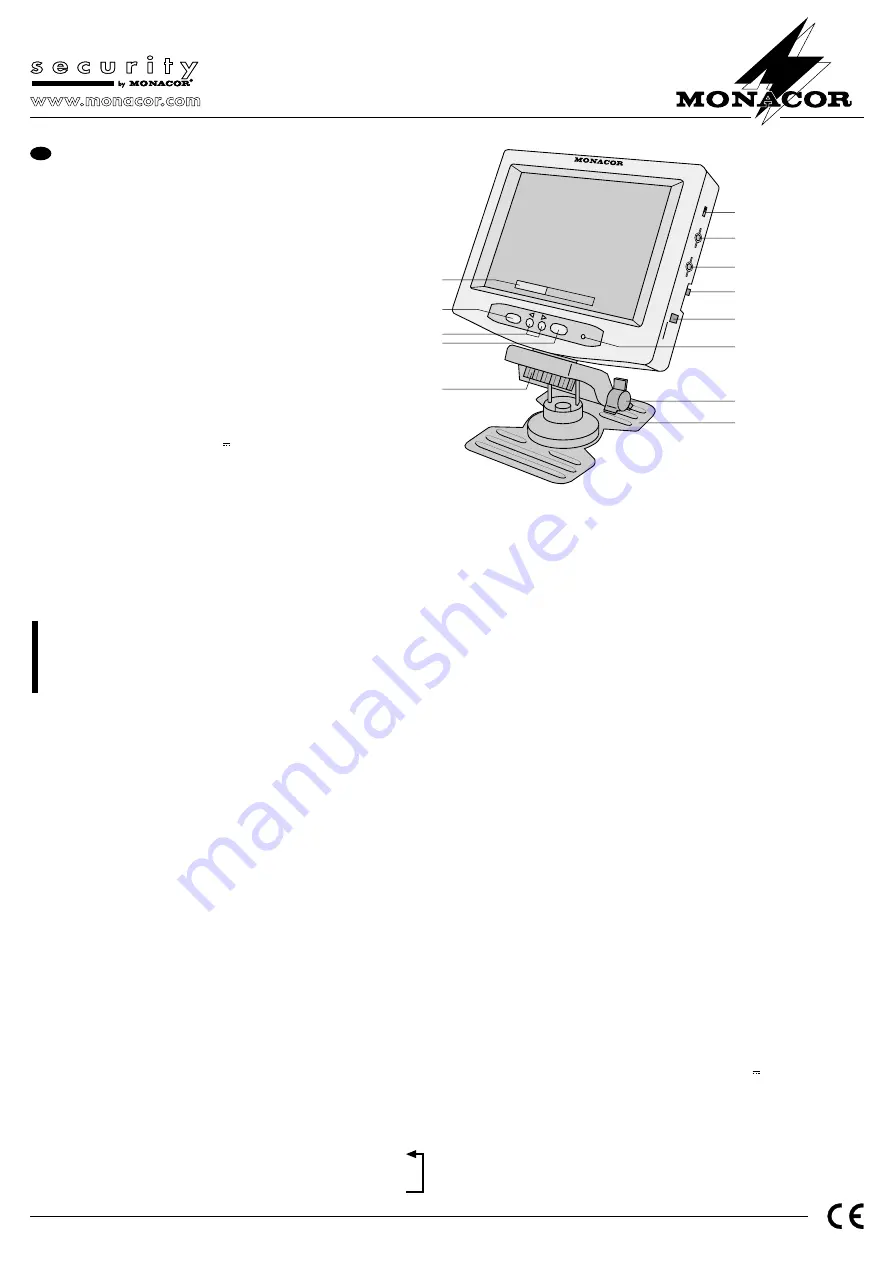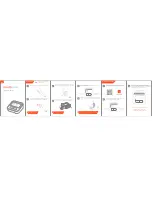
LCD Colour Monitor
1 Operating Elements and Connections
1 Screen menu
2 Button MODE for inserting the screen menu and
for selecting the functions contrast, brightness,
colour, and volume
3 Buttons
"
and
#
for adjusting the selected function
4 Button POWER for switching on and off for short
interruptions
5 Mounting screw for screwing the monitor to the
stand
6 Selector for picture display
NOR = normal display
MIR = mirror-inverted display
7 Input AUDIO for connecting the audio output of the
signal source
8 Input VIDEO for connecting the video output of the
signal source
9 ON/OFF switch
10 Jack DC IN for power supply (12 V ), e. g. via the
supplied plug-in power supply unit
11 Power LED
12 Setscrew for the hinge of the stand to adjust the
monitor inclination
13 Stand
2 Safety Notes
The units (monitor, plug-in power supply unit) corre-
spond to the directive for electromagnetic compatibi-
lity 89/336/EEC. The plug-in power supply unit addi-
tionally corresponds to the low voltage directive
73/23/EEC.
The plug-in power supply unit is supplied with
hazardous mains voltage (230 V~). Leave servicing
to skilled personnel only. Inexpert handling may
cause an electric shock hazard. Furthermore, any
guarantee claim will expire if one of the units has
been opened.
Please observe the following items in any case:
●
The units are suitable for indoor use only. Protect
them against humidity and heat (admissible ambient
temperature range 0 – 40 °C).
●
Even with the monitor switched off, the plug-in
power supply unit has a low current consumption.
●
The heat generated within the unit must be carried
off by air circulation. Therefore, do not cover the air
vents on the rear side.
●
Do not operate the monitor or immediately dis-
connect the plug-in power supply unit from the
mains socket
1. if there is visible damage to the plug-in power
supply unit or to the monitor,
2. if a defect might have occurred after the unit was
dropped or suffered a similar accident,
3. if malfunctions occur.
In any case the unit must be repaired by skilled per-
sonnel.
●
For cleaning only use a dry, soft cloth, by no means
chemicals or water.
●
If the units are used for other purposes than ori-
ginally intended, if they are not operated correctly or
not repaired in an expert way, no liability for any
damage will be accepted.
●
If the units are to be put out of operation per-
manently, take them to a local recycling plant for
disposal.
3 Applications
This LCD colour monitor in TFT active matrix techno-
logy offers a sharp, quick and high-contrast picture
display. It is suitable for universal applications, e. g. in
monitoring systems, in car rear monitoring systems
(mirror-inverted picture display can be selected), or for
multimedia applications. An integrated small speaker
allows sound reproduction.
4 Installation
The monitor can be installed on the supplied stand
(13). It can also be mounted on a corresponding sup-
port with a 6.3 mm (
1
/
4
") thread.
1) Place the stand on a horizontal surface. To improve
its stability, fasten it with screws or glue it on by
means of the self-adhesive foil. For wall mounting,
screw the stand at a suitable location on the wall.
2) Screw the monitor to the stand by means of the
mounting screw (5). According to the desired
viewing angle, either use the thread on the lower
edge of the monitor (shown in the figure) or use the
tightening nut in the guide rail on the rear side of
the monitor (e. g. for wall mounting or for horizontal
positioning).
3) Release the setscrew (12) and adjust the monitor
inclination. Tighten the screw again.
5 Connection
1) Connect the video output of the signal source (ca-
mera, video recorder, etc.) to the jack VIDEO (8)
via the supplied adapter cable.
2) Connect the audio output of the signal source to
the jack AUDIO (7) via the supplied adapter cable.
3) Connect the low voltage plug of the power supply
unit to the jack DC IN (10) and then connect the
power supply unit to a mains socket (230 V~/
50 Hz).
However, power supply of the monitor is also
possible via another 12 V power source (e. g. car
battery). For connection, a low voltage plug 3.5/
1.3 mm (inside/outside Ø) is required. The positive
pole must be at the centre contact.
6 Operation
1) Switch on the unit with the lateral sliding switch
ON/OFF (9) [position ON]. The green LED (11)
lights up. The screen brightens and PAL / LCD 5.6"
is inserted for a short time.
Note: If the screen remains dark, there is no video
signal at the jack VIDEO (8). The unit switches to
the power saving mode.
2) Use the screen menu (1) to adjust an optimum pic-
ture and volume. Insert the screen menu with the
button MODE (2). Press the button MODE so many
times until the desired function appears.
Sequence of functions:
CONTRAST
BRIGHTNESS
COLOR
VOLUME
Adjust the selected function with the buttons
"
and
#
(3) [setting 00 to 255].
3) Select the picture display with the selector MIR/
NOR (6):
NOR = normal display
MIR = mirror-inverted display
4) If the screen menu hides an important section of
the picture, it can be displaced horizontally and ver-
tically:
a) Switch off the monitor with the sliding switch
ON/OFF (9).
b) Keep the buttons MODE (2) and
"
(3) pressed
while simultaneously switching on again the
monitor with the sliding switch.
c) For horizontal displacement, select the menu
OSD HP with the button MODE (2) [setting 06 to
22]. For vertical displacement, use the menu
OSD VP (01 – 50). Displace the menu with the
buttons
"
and
#
(3).
d) To end the adjusting mode, switch off the moni-
tor with the sliding switch (9).
5) For short interruptions, switch on and off the moni-
tor with the button POWER (4). For switching off in
general, use the sliding switch ON/OFF (9).
6) If the monitor is not used for a longer period, dis-
connect the plug-in power supply unit from the
mains socket, as it even has a low current con-
sumption when the monitor is switched off.
7 Specifications
Screen: . . . . . . . . . . . . . . TFT active matrix
Screen diagonal: . . . . . . 14 cm (5.5")
Colour system: . . . . . . . . PAL
Synchronization: . . . . . . . hor. 15 625 Hz, vert. 50 Hz
Resolution: . . . . . . . . . . . hor. 960 x vert. 234 pixels
Video input: . . . . . . . . . . 1 Vpp/75
Ω
Audio input: . . . . . . . . . . 30 mV/10 k
Ω
Audio output power: . . . . 0.5 W
MAX
Power supply: . . . . . . . . . 12 V
, 500 mA
via plug-in power supply at
230 V~/50 Hz/17 VA
Ambient temperature: . . . 0 – 40 °C
Dimensions: . . . . . . . . . . 160 x 133 x 37 mm
Weight: . . . . . . . . . . . . . . 500 g
According to the manufacturer.
Subject to technical change.
®
TVLCD-560COL
Order No. 19.5830
Copyright
©
by INTER-MERCADOR GmbH & Co. KG, Bremen, Germany All rights reserved. MONACOR
®
International
07.00.01
MODE
POWER
D
C
I
N
O
N
/
O
F
F
V
ID
E
O
A
U
D
IO
M
IR
/
N
O
R
®
TVLCD-560COL
CONTRAST 9
7
1
2
3
4
5
6
7
8
9
10
11
12
13
GB






















